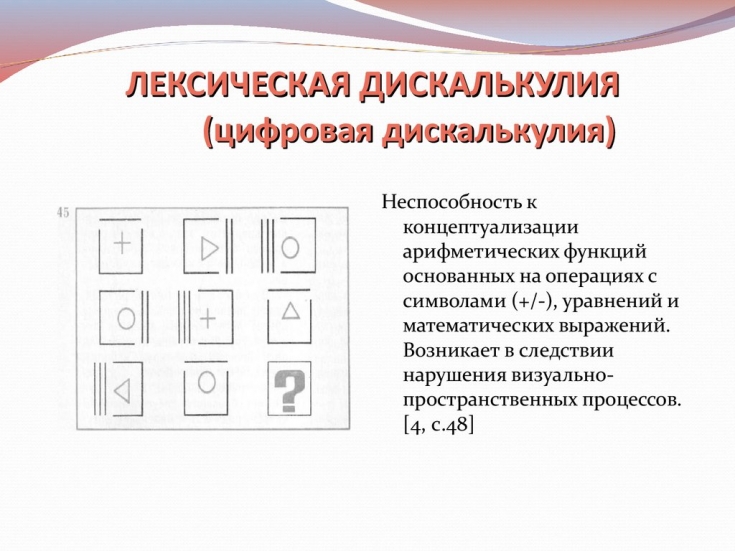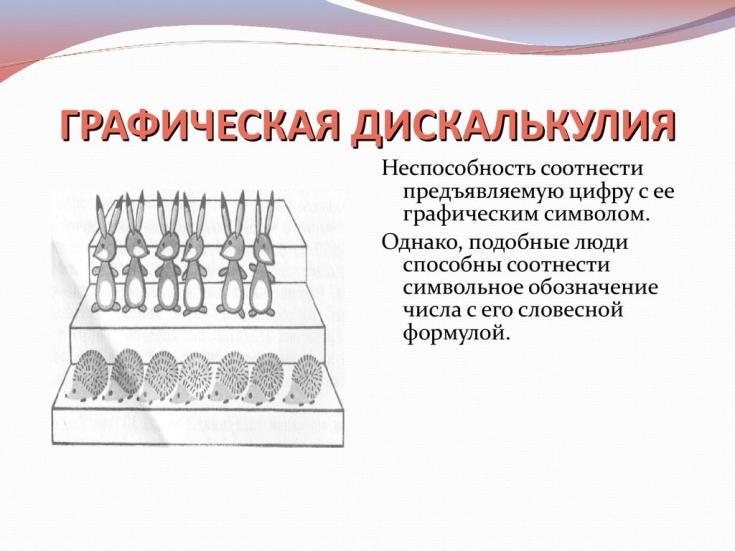There are many possible pathologies in the development of children. Thankfully they are rare. But this, at the same time, reduces the chances of detection in time.
If a child at preschool age is poorly versed in numbers, you should not expect that he will outgrow everything and everything has its time. Perhaps the reason for the arithmetic misses is dyscalculia.
This term defines deviance, which is characterized by a lack of ability to learn and understand arithmetic operations. A person does not know how to operate with figures and numbers.
How serious is the disorder? The editors of estet-portal.com suggest considering the causes, signs and options for correcting pathology.
1. Where and when to look for the cause of dyscalculia
2. What symptoms indicate dyscalculia
3. Dyscalculia: how and when to diagnose
4. The essence of the treatment and correction of dyscalculia
5. How Parents Can Help Overcome Dyscalculia
Where and when to look for the cause of dyscalculia
If you suspect your child has numeracy problems, don't be so quick to blame yourself.
The main reason for the manifestation of the disease – underdevelopment of the parietal lobe of the brain, which may become the result of:
● the development of complications during the period of bearing a child and during childbirth (asphyxia, prolonged toxicosis, the birth of a premature baby);
● influence of genetic predisposition or hereditary disease;
● wrong diet;
● early head trauma;
● presence of a tumor in the brain;
● transferring a neuroinfection.
The development of the disorder is directly influenced by the fear of arithmetic as a subject and possible punishment, a poor social environment of the child (a dysfunctional family).
What symptoms indicate dyscalculia
You can also notice a problem in a child yourself by the following symptoms:
● inability to recognize the number of objects by external indicators when they offer the child to count them one by one;
● inability to correctly perceive the concepts of "more" and "less than";
● incorrect coordination of movements;
● computing difficulties;
● inability to abstractly calculate time;
● lack of understanding in solving simple arithmetic problems;
● inability to perform actions on logic and abstractness.
The presence of even one, and even more so several symptoms in your child should alert you.
To recognize the pathology, it is best to to visit a specialist in order to dispel all doubts and not confuse it with some other little-known pathology, for example, Tourette's syndrome.
The causes of dyscalculia are associated in the vast majority of cases with deformities in the brain, and the main symptoms are already noticeable at preschool age.
Dyscalculia: how and when to diagnose
When can pathology be detected?
The first symptoms will be noticeable before the age of 6, because children have a need to do elementary calculations.
An accurate diagnosis can be established if you seek help from a child psychologist or speech therapist. Diagnosis is made by examining the child and applying differential diagnosis methods.
The child is given the following tests to complete:
● calculate the numbers from 10 to 20 (after all, counting up to 10 can be normal even in the presence of pathology);
● name and distribute different figures according to color indicators;
● indicate numbers in ascending order and then in descending order;
The essence of therapy and correction of dyscalculia
Several specialists are included in the treatment process at once to obtain the best result, including neurologists, speech therapists, etc. Therapy consists in the organization of speech therapy and training sessions.
Treatment is aimed at correcting the pathology and is carried out in compliance with the following rules:
● at first, classes are held individually, and then in groups where there are children with the same problems;
● classes have a game form;
● the task of teachers – develop the logic of calculation operations and teach to understand them;
● classes are held aimed at expanding the child's vocabulary and speech literacy;
● Attention is also paid to drug therapy, which is aimed at improving the functioning of the brain and activating the nervous system of the child;
 You can turn on
You can turn on
Available pathology correction options that you can carry out in a playful way are as follows: ● classes in the kitchen, when you invite your child to cook something together, and during the process, count the necessary ingredients and focus on numbers;
● discussion of the cost of products in the store, when you offer the crumbs to make a choice – for example, sweets, taking into account their cost, explaining what is more expensive and what is cheaper;● classes with the clock, during which you from time to time ask the child what time it is, praise him for the correct answer, and in case of an incorrect definition, help to understand the dial, explaining the significance of time for a person.
With dyscalculia, a child can be taught to count. Timely diagnosis will ensure the correction of the pathology and overcome the problem.So,
discalculation
– a disorder that, in simple words, manifests itself in the inability to count.Even simple arithmetic calculations cause difficulties for the patient, so it is important not to let things take their course when signs are present. After all, the problem is serious, since mathematical knowledge is necessary in modern society, and their absence leads to inadequate socialization of a person.
We deal with numbers all the time: paying fares, looking at the clock, shopping at the store, and even counting the number of birthday guests. Deviation treatment is aimed at developing skills in solving arithmetic problems and a full understanding of everything related to numbers.
Oligophrenia: stages of mental retardation and how to identify them
You might be interested in: memory test.











Add a comment